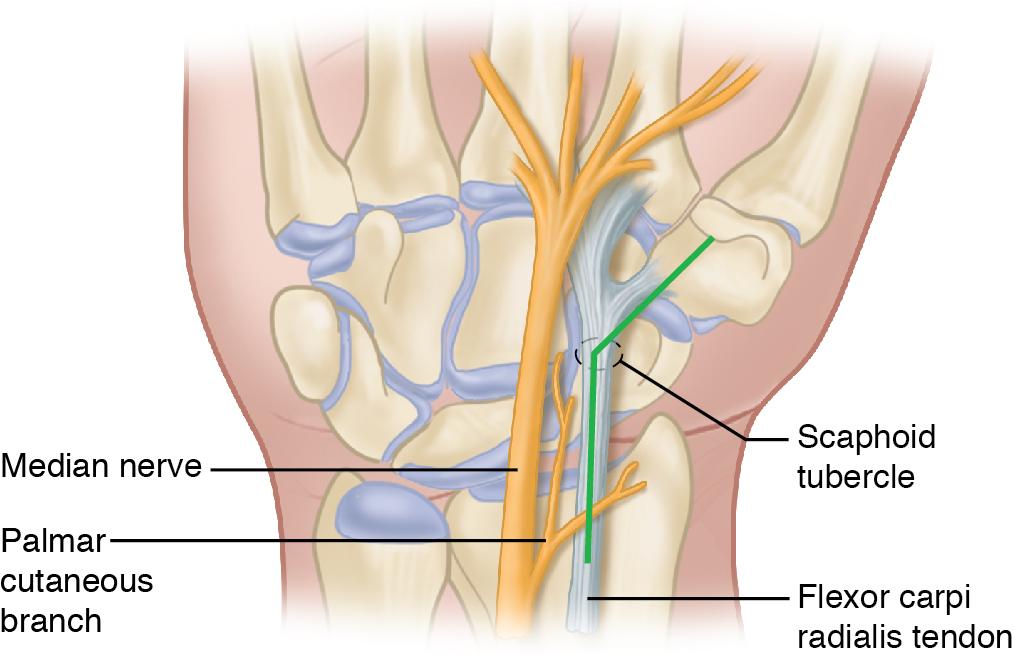Physical Address
304 North Cardinal St.
Dorchester Center, MA 02124
![]() See also .
See also .
Treatment of scaphoid fractures is determined by displacement and stability of the fracture. Operative treatment is generally required for displaced, unstable fractures in which the fragments are offset more than 1 mm on the anteroposterior or oblique view, lunocapitate angulation is more than 15 degrees, or the scapholunate angulation is more than 45 degrees on the lateral view (range 30–60 degrees). Reduction can be attempted initially by longitudinal traction and slight radial compression of the carpus. If the reduction attempt is successful, percutaneous fixation with a cannulated screw or pins and application of a long arm thumb spica cast may suffice. Otherwise, open reduction and internal fixation may be required.
With the patient supine and preferably under regional anesthesia, prepare the hand and wrist and inflate a pneumatic tourniquet.
The volar approach usually gives the best exposure for scaphoid fractures at and distal to the waist. Make a longitudinal skin incision over the palmar surface of the wrist beginning 3 to 4 cm proximal to the wrist flexion crease over the flexor carpi radialis.
Extend the incision distally to the wrist flexion crease and angle it radially toward the scaphotrapezial and trapeziometacarpal joints in a hockey-stick configuration ( Fig. 40.1 ).

Protect terminal branches of the palmar cutaneous branch of the median nerve and the superficial radial nerves.
Reflect skin flaps at the level of the forearm fascia.
Open the sheath of the flexor carpi radialis, retract the tendon ulnarly, and open the deep surface of its sheath.
Expose the palmar capsule of the joint over the radioscaphoid joint.
Extend the wrist in ulnar deviation, open the capsule in the longitudinal axis of the scaphoid bone, and obliquely extend the incision toward the scaphotrapezial joint.
With sharp dissection, expose the fracture, incise the long radiolunate and radioscaphocapitate ligaments, preserving each leaf of these capsuloligamentous structures for later repair. Inspect the fracture to determine the need for bone grafting.
If comminution is absent or minimal, reduction and fixation suffice. If comminution is extensive, especially on the palmar surface and with a tendency to flexion of the scaphoid at the fracture, obtain an iliac crest bone graft.
Kirschner wires placed in the distal and proximal poles as toggle levers (“joysticks”) help to manipulate the fragments.
Reduce the fracture and fix it with Kirschner wires or a screw technique (e.g., cannulated screws), avoiding rotation or angulation. If a cannulated device is used, ensure that the guidewire is centered in the proximal and distal poles. Image intensification with C-arm fluoroscopy is helpful for this step.
For fractures through the waist and in the distal pole, insert the fixation device through a distal portal. Create the distal portal by opening the scaphotrapezial joint with a longitudinal capsular incision.
Remove a portion of the trapezium with a rongeur to allow placement of the guidewire from distal to proximal.
Insert the screw until the trailing end (head) is flush with subchondral bone, countersunk beneath the articular cartilage.
Placement of Kirschner wires down the long axis of the scaphoid is made easier by gentle radial deviation of the wrist aligning the scaphoid vertically and placing a towel bump at the dorsal wrist flexion crease. Finger-trap traction on the thumb and index finger can also be helpful.
After stable reduction and fixation are obtained, check the position and alignment of the reduction and the placement of the internal fixation with image intensification or radiographs.
Deflate the tourniquet and obtain hemostasis.
Insert a drain if needed and close the wrist capsule with nonabsorbable sutures or long-lasting absorbable sutures.
Close the skin and apply a dressing that includes a thumb spica splint.
Become a Clinical Tree membership for Full access and enjoy Unlimited articles
If you are a member. Log in here